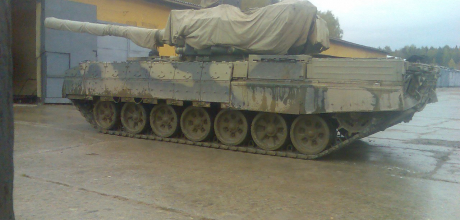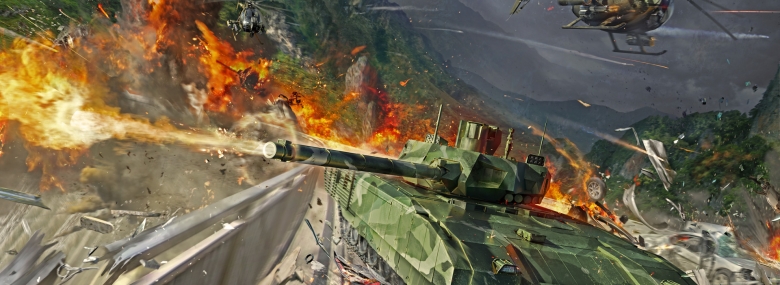
Every now and then, a picture of an armored vehicle will appear on the internet often posted by someone excited about finding something new and unusual, making a mark on the pages of armored warfare history. The reality, however, is usually disappointing.

IS heavy tank cosplaying as KV-2 by Mosfilm
While discoveries of new armored vehicles based on historical photographic evidence are possible (if rare), the majority of cases of "newly discovered vehicles" can be attributed, apart from less-known existing vehicle variants, to one of two categories:
- Cinema Armor
- Opposing Force Armor
Let's take a closer look at both these types of vehicles and some of their most common "tells".
Cinema Tanks
Every proper big screen movie set in a modern war has to have a dramatic scene where a tank (or at least a personnel carrier full of soldiers) appears only to be dispatched by the daring hero. Cinema tanks are armored vehicles (or even trucks in some cases) masquerading as tanks for the purpose of the movie. The use of armored vehicles for cinematic purposes goes back to the Second World War (although there are some even older examples).
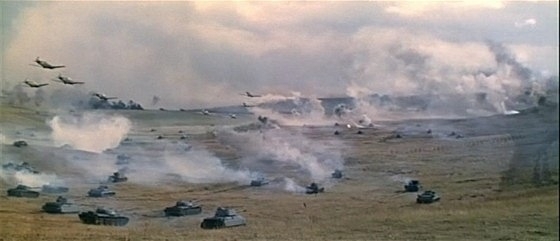
Shot from the Soviet movie "Liberation" - notice the T-54
Very early on, the tanks appearing in movies were often actually real wartime or surplus vehicles, but such tanks could usually only cover the allied side (hundreds of T-34s and Shermans were readily available). In the 1950s and 60s, movie directors and producers faced a major problem:
"Who will play the bad guys?"
German tanks in working condition were – even right after the war – quite rare. As barbaric as it might sound to us today, in the war-ravaged world of 1945, metal was at a premium and almost all captured armored vehicles – especially the broken-down ones – were almost immediately scrapped to fuel the restoration of Europe. This, unfortunately, included some quite rare prototypes and this is why relatively few German vehicles have survived to this day.
The movie industry was able to compensate for this in various ways. In some older American films, the role of the German tanks was played by M47 Pattons with German crosses painted on them – the moviemakers (quite correctly) assumed the average moviegoer would not be able to tell the tanks apart anyway, so why bother when a big black balkenkreuz (or swastika) was enough to identify the bad guys.

In the American movie "Patton", German Panzers were cosplayed by... Pattons
Russian cinema, however, went further, partially thanks to the vast amount of resources poured into making dramatic historical movies. The boxy shape of the Tiger was – and still is – something so iconic that it simply had to be shown. The epic Soviet movie series Liberation showed hordes of Nazi Tigers played by T-34 tanks that had had their turrets and hulls covered by wooden, boxy kits. The suspensions were unmistakable. Despite the somewhat amateurish look of some of these visual modifications, the scale of the movies is impressive even by today's CGI standards. In later movies, the role of the German tanks usually fell to T-54s or even IS series tanks.

Czechoslovak-built Tiger replica, starred in several movies
In some rare instances, especially in the Eastern Bloc, movie makers went even further and used real captured German vehicles for proper realism. One such movie is the 1977 Czechoslovak Liberation of Prague, where actual Panzer IVs played the role of Panzer IVs! After the war, the Czechoslovak army had – if only for a short time – used a number of these refitted vehicles in active service. They were phased out relatively quickly. Many were sold to Syria, which is why Panzer IVs and StuGs were fighting the Israelis in the desert two decades after the end of the war, but some remained in army reserves for decades. The director went as far as to actually burn down one of these vehicles for added realism – something completely unthinkable today. And of course, no such movie would be complete without at least one Tiger – in this case, the Tiger was once again played by a converted T-34, which can be seen today in the Lešany military museum.

Panzer IV, destroyed during the shooting of the "Liberation of Prague" movie
With the onset of the internet and the interest in armored vehicles sparked by computer games, the demand for additional realism spawned some extremely interesting conversions. The most remarkable movies in this sense include:
- Saving Private Ryan, with its Tiger built (once again) on a T-34/85 chassis (compared to the early visual modifications of the T-34, this vehicle was beautifully made and looked quite realistic)
- White Tiger with a Porsche Tiger on an IS chassis
- Fury with the actual Tiger 131
Fury is perhaps the ultimate tank movie, with actual historical Shermans taking part in the shooting and the only running Tiger in the world – the legendary Tiger 131 from Bovington.
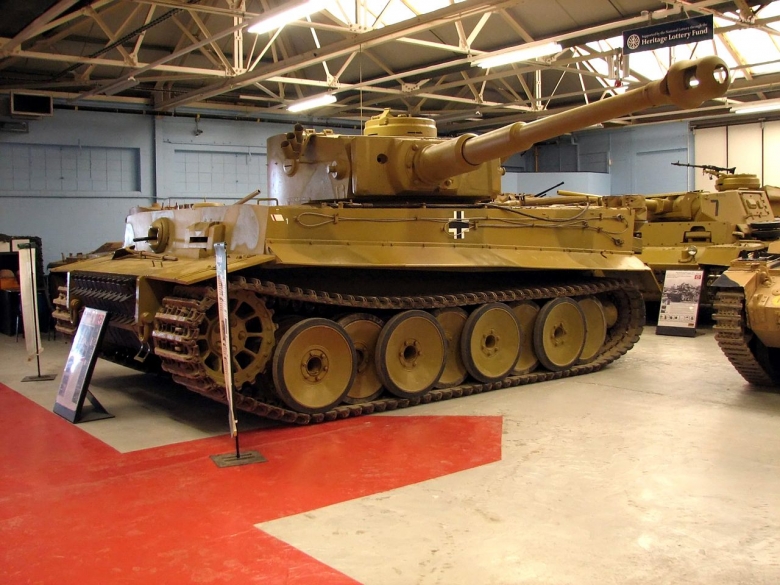
Tiger 131 in Bovington
To include such vehicles in a movie is extremely costly, leading other movie makers to utilize various replicas instead. For example, a typical Panzer III in modern movies is a modified British FV432 APC. The reason for that is that FV432s are actually both available and relatively affordable in Britain, leading to some very interesting conversions. These can be told apart from the real thing by looking at the roadwheels – an actual Panzer III has 6 roadwheels, while replicas typically only have 5.
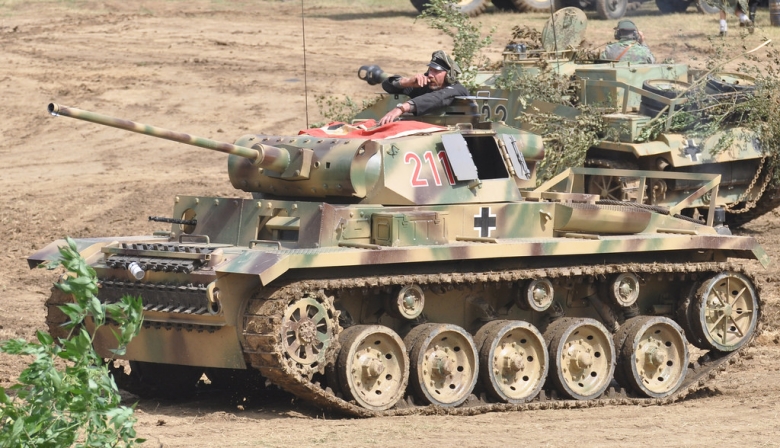
Panzer III replica on FV432 chassis, notice the roadwheels
The movies do not just show wartime tanks. Sometimes, the plot calls for an insidious force of conveniently deployed Soviets to take over United States territory.
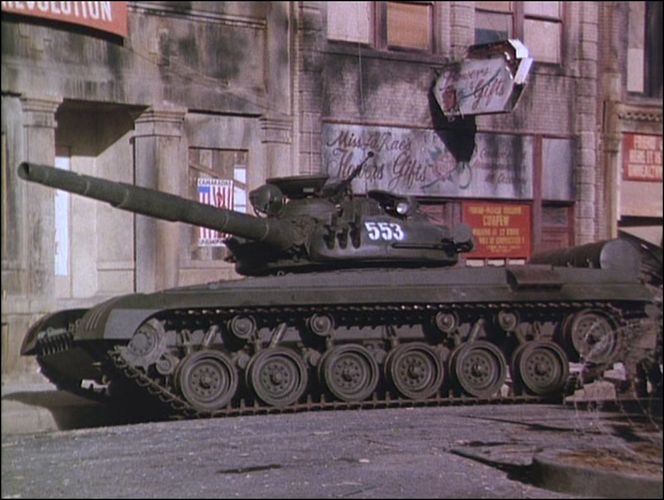
Red Dawn movie "tank", built on the M8A1 tractor chassis
The role of the Soviet tanks is usually played by modified Pattons, although one particular well-known exception is the T-72 in the movie Red Dawn, built on the chassis of an M8A1 Tractor, which in turn is based on the M41 Walker Bulldog chassis. Its picture regularly appears on various dedicated armor forums as new users bring it up asking about the identity of the "Soviet" tank.
Opposing Force (OPFOR)
Opposing Force vehicles are something else entirely, although they do have the "pretending" aspect in common with the cinematic tanks. They are active service (or even obsolete) vehicles visually modified for training purposes to represent the Opposing Force – typically Soviet designs for the Americans and vice versa.

M551 Sheridan, modified to represent the Soviet T-80 MBT
The tradition of modifying vehicles to represent the enemy is very long and goes back to the Second World War and possibly even further. A large number of vehicles have been modified like this over the years. Virtually every military uses its opposing force vehicles (with enemy tactics) to train its troops, sometimes to great detail. Some of the best-known such vehicles (apart from the actual captured or purchased T-54s and T-72s) were the Sheridans, modified to represent Russian MBTs.
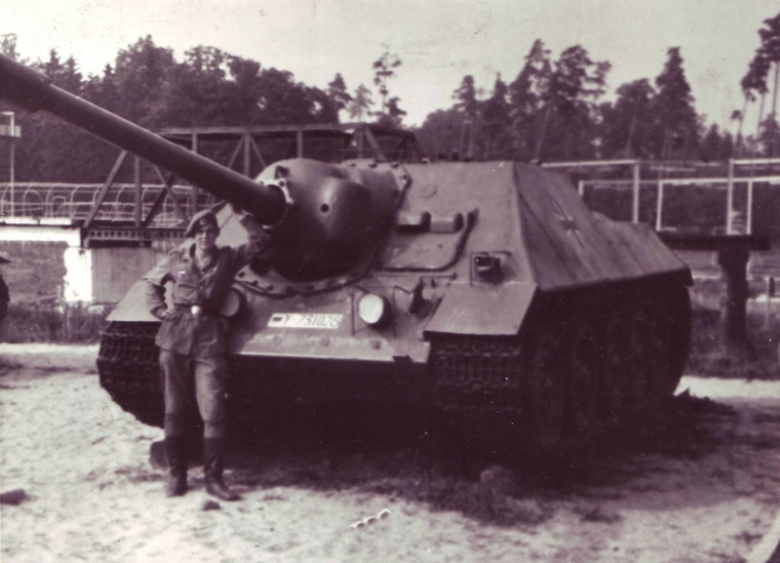
OPFOR SU-100, masked as a West-German Kanonenjagdpanzer
The U.S. Army, however, has the advantage of being able to access a large number of Soviet/Russian vehicles, purchased from former Eastern Bloc countries. Many former Czechoslovak and Polish vehicles ended up in the United States, partially in private hands and partially in U.S. service as training tools.

Centurion, modified to look like a T-80 on western radars
One specific sub-group of OPFOR vehicles are the vehicles modified to represent the radar returns of certain vehicles, used to train future radar crews. They are typically recognized by their exaggerated shapes, which are supposed to emulate the shape of the originals.
Conclusion
With ever increasing CGI power and its use in cinematography, it is possible that computer images will replace the actual use of armor in some movies. However, when it comes to sheer realism, nothing can beat a physical vehicle and we are likely to see more cinema armor appearing on the big screen and confusing internet users for years to come. As for the OPFOR vehicles, they too will continue to be used and it is very likely only a question of time before pictures of an American vehicle masquerading as a T-14 Armata appear as well.





